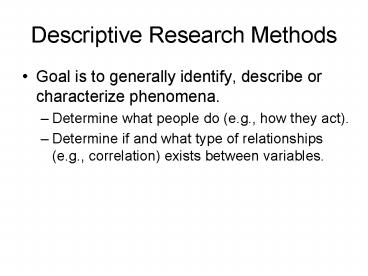Descriptive Research Methods - PowerPoint PPT Presentation
1 / 6
Title:
Descriptive Research Methods
Description:
Uses preexisting information (data) to help answer research questions. ... (e.g., McCarthy's Blacklist; Titchener on Wundt) Negative Case Analysis ... – PowerPoint PPT presentation
Number of Views:84
Avg rating:3.0/5.0
Title: Descriptive Research Methods
1
Descriptive Research Methods
- Goal is to generally identify, describe or
characterize phenomena. - Determine what people do (e.g., how they act).
- Determine if and what type of relationships
(e.g., correlation) exists between variables.
2
Archival Research
- Uses preexisting information (data) to help
answer research questions. - Archival data is often recorded by individuals
other than the researchers, for other purposes
(e.g. public health records and census data)
3
Types of Archival Research
- Statistical Records
- e.g., Does heat relate to aggression? (Reifman,
Larrick Fein, 1991) - Survey Archives
- e.g.,The General Social Survey a series of
surveys funded by the National Science Foundation
as a resource for social scientists (see
website-General Social Survey Series - Written and Mass Communication Records
- e.g., Do peoples preferences for others vary
based on the economy? Pettijohn_Archival Study.pdf
4
Limitations to Archival Data
- Availability/Survival of relevant records (e.g.,
Rosetta Stone, Dead Sea Scrolls) - Accuracy of records/Selective Deposit
- (e.g., McCarthys Blacklist Titchener on Wundt)
- Negative Case Analysis
5
Telling a story from Archival Data
- Use of Content Analysis
- A technique for drawing inferences by
systematically and objectively identifying
specified characteristics in archival data. - Involves a systematic application of a coding
system across a representative sample of material
- Applies theory to inform decision rules for
organizing the data into relevant variables.
6
Steps in Performing a Content Analysis
- Choose the phenomena to be coded
- Select the archival data to be used (be careful
that the data be representative) - Derive a coding scheme (i.e., specify categories
of interest). - Choose a sampling strategy (e.g., every other
issue of a magazine over a years period) - Train coders or decide on criteria for inclusion
of content into the categories - Analyze the data































